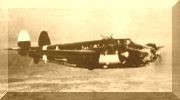Caproni Ca.135
| Caproni Ca.135 | |
|---|---|
 |
|
| Role | Medium bomber |
| Manufacturer | Caproni |
| Designer | Cesare Pallavicino |
| First flight | 1 April 1935 |
| Introduction | 1937 |
| Primary users |
Regia Aeronautica Hungarian Air Force Peruvian Aviation Corps |
| Produced | 1936-1941 |
| Number built | c. 140 |
The Caproni Ca.135 was an Italian medium bomber designed in Bergamo in Italy by Cesare Pallavicino. It flew for the first time in 1935, and entered service with the Peruvian Air Force in 1937, and with the Regia Aeronautica (Italian Royal Air Force) in January 1938.
A proposed variant with more powerful engines designated the Caproni Ca.325 was built only in mock-up form.
General Valle (Chief of Staff of the Regia Aeronautica) initiated the "R-plan" - a program designed to modernize Italy's air force, and to give it a strength of 3,000 aircraft by 1940. In late 1934 a competition was held for a bomber with the following specifications:
The ceiling and range specifications were not met, but the speed was exceeded by almost all the machines entered. At the end of the competition, the "winners" were the Ca.135 (with 204 aircraft ordered), the Fiat BR.20 (204), the Piaggio P.32 (144), the Savoia-Marchetti SM.79 (96), the CANT Z.1007 (49), and the Piaggio P.32 (12).
This array of aircraft was proof of the anarchy, clientelarism, and inefficiency that afflicted the Italian aviation industry. Worse was the continuous waste of resources by the Regia Aeronautica (Italian Royal Air Force). Orders were given for aircraft that were already obsolete. The winners of the competition were not always the best - the BR.20 was overlooked in favour of the SM.79, an aircraft which was not even entered in the competition.
The Ca.135 was to be built at Caproni's main Taliedo factory in Milan, which is why the type had a designation in the main Caproni sequence, rather than in the Caproni-Bergamaschi Ca.300 series. However, the project was retained at Ponte San Pietro and the prototype, completed during 1934-35, (a long construction time for the period), was first flown on 1 April. The project chief was Cesare Pallavicino of CAB (Caproni Aereonautica Bergamasca).
...
Wikipedia
